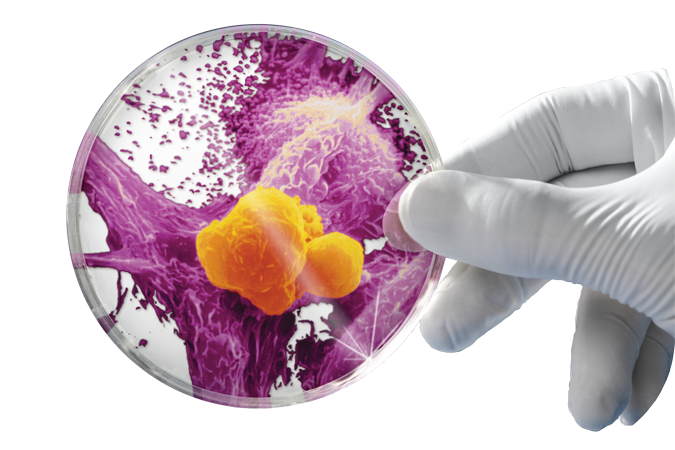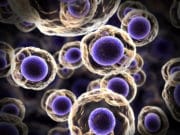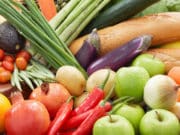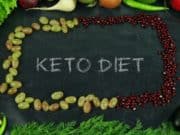Colon cancer is rampant! This is caused by the slow evacuation and the putrefaction in the colon of the remains of meat. Lifelong vegetarians never suffer from such an illness. Many meat eaters believe that meat is the sole source of protein. However, the quality of this protein is so poor that little of it can ever be utilized by humans because it is incomplete and lacks the correct combination of amino acids, the building blocks of protein. Studies show that the average American gets five times the amount of protein needed. It is a common medical fact that excess protein is dangerous, the prime danger being that uric acid (the waste product produced in the process of digesting protein) attacks the kidneys, breaking down the kidney cells called nephrons. This condition is called nephritis; the prime cause of it is overburdening the kidneys. More usable protein is found in one tablespoon of tofu or organic soybeans than the average serving of meat!
Have you ever seen what happens to a piece of meat that stays in the sun for three days? Meat can stay in the warmth of the intestine for at least four days until it is digested. It does nothing but wait for passage. Often, it usually stays there for much longer, traces remaining for up to several months. Colonic therapists always see meat passing through in people who have been vegetarians for several years, thus indicating that meat remains undigested there for a long time. Occasionally this has been documented in twenty-year vegetarians!
Tigers or lions who eat meat and grow strong on it have acid-based digestive systems. Our Hydrochloric Acid isn’t strong enough to fully digest meat. Also, their intestines are in a straight run of about five feet long, not twisted and turned, layer over layer, compacted into a small area like the human intestine, which is twenty feet long.
Some vegetarians claim they are more satisfied after they eat. The reason for this is that there are fewer ketones (protein-digestive substances) formed when vegetable protein is digested. For many, ketones cause a trace amount of nausea which one normally interprets as a decreased desire for food due to this uncomfortable and slight degree of queasiness. Although the body calls for more food, the taste buds tolerate less. This is the danger of the popular high-protein diet substances on the market. This abnormally high level of ketones is called ketosis and refers to the state of starvation that the body incurs due to the inability of the appetite to call for nutrition. Most Americans who eat the wrong type of carbohydrates never recognize the high amount of complex carbohydrates required to overthrow this condition. Also, when the blood ketone level is too high, it results in abnormally acidic blood, called acidosis, which dramatically destroys the immune defence, thus provoking many hard illnesses.
It’s no secret that red meat can be harmful to our health — while high in protein, it’s also packed with fats that can contribute to heart disease and diabetes and other compounds that can promote cancer. Now researchers led by An Pan at the Harvard School of Public Health quantify how eating red meat can hasten early death.
Using data from two long-running studies of health professionals, researchers tracked the diets of more than 121,000 middle-aged men and women for up to 28 years. Roughly 20% of the participants died during that period.
On average, each additional serving of red meat the participants ate per day was associated with a 13% higher risk of dying during the study. Processed red meat products — such as hot dogs, bacon, and salami — appeared to be even more dangerous: Each additional daily serving was associated with a 20% higher risk of dying.
Based on these findings, the researchers estimate that substituting one daily serving of red meat with fish, poultry, nuts, legumes, whole grains, or low-fat dairy products would reduce the risk of dying in this stage of life by 7% to 19%. If everyone in the study had slashed their average red-meat intake to less than half a serving per day, the researchers say, 9% of deaths among men and 8% of deaths among women could have been prevented.
Meat substitutes
When making the change, it’s important to think about vegetarian substitutes for nutrients that largely come from meat, poultry, and fish.
Regarding Protein. Try beans, lentils, tofu, and chickpeas, as well as increasing your intake of greens and whole grain bread/ pasta.
Regarding Iron. Try spinach, dried fruits, cashews, and tomatoes, and look for iron-fortified cereal or oatmeal for breakfast
Regarding Calcium. Increase your intake of dairy products, and try broccoli, kale, and mustard greens.
Regarding Omega-3. Omega-3 fatty acids are mostly found in fish and are required for our bodies.Thus as a substitute, try flaxseed, lentils, okra, kale, avocado, olive oil and walnuts.
Legumes
Legumes are loaded with fiber that helps lower cholesterol, cleanse the intestines, and regulate blood sugar levels. Legumes also help protect the body against cancer. Legumes are a great way to add protein, fiber and folate to your diet. The major health benefit of common beans is their rich source of cholesterol-lowering fiber. In addition to lowering cholesterol, the high fiber content of beans prevents blood sugar levels from rising too rapidly after a meal, making these beans an especially good choice for individuals with diabetes, insulin resistance, or hypoglycemia.
Legumes are often considered an ‘incomplete’ protein, because they don’t contain all the essential amino acids that we need in our diet, as opposed to ‘complete’ protein found in foods of animal origin, such as fish, dairy products and eggs, which contain ample amounts of the essential amino acids. Although it’s important to get all the amino acids, both essential and non-essential, it’s not necessary to get them from heavy food. In fact, because of its high fat content – as well as the use of antibiotics and other chemicals in the raising of poultry and cattle – most of the animal protein should be eaten only in moderation.
The best way to go about it is to combine partial-protein foods to make complementary protein. For instance, although beans and brown rice are both rich in protein, each lack one or more of the necessary amino acids. So if you combine them together, you form a complete protein that is a high quality substitute for meat.
To make a complete protein combine beans with one of the following: brown rice, corn, nuts, seeds, organic wheat.
Lentils
Lentils are members of the Fabaceae or Leguminosea family of plants so are related to the chickpea,pea, green bean, borlotti bean, and others. Lentils come in a variety of colours, red, brown, green, black, white, yellow and orange, but all contain large amounts of protein. They contain vitamins A, C, E, and K, lots of molybdenum, amino acids including choline, B-complex vitamins, B1 (thiamin) B2 (riboflavin), B3 (niacin), pantothenic acid and B6 (pyridoxine). They are rich in minerals, containing magnesium, manganese, copper, zinc, iron and calcium. They also contain Omega-3 and -6 fatty acids.
Lentils help to lower cholesterol levels and are a heart-healthy food. They can help to stabilize blood sugar levels and normalize blood pressure. Because they are low in calories and high in dietary fibre and folate, they are wonderful for people on a weight-loss diet as they prevent constipation and have anti-inflammatory actions so are good for irritable bowel syndrome sufferers and for people with colon problems. The vitamins and minerals they contain have powerful antioxidant properties so they can combat the scavenging free radicals which can cause damage to healthy cells and cause cancer.
If you allow them to sprout, they make very nutritious bean sprouts for salads and stir-fries and you can do this by soaking them in warm water for about 12 hours, then leaving them to sprout for 5 days.
If you grind dried lentils the flour can be added to cereal flour to make a protein-enhanced bread, and if you make a paste of lentils and apply this to old ulcerous wounds, it will cleanse them and promote new skin growth.
Hippocrates (circa 460 – 377BC) prescribed lentils for liver problems and to keep old men virile. Interestingly modern research has shown that choline helps to rid the liver of fats, so helping it function more efficiently to get rid of toxins in the bloodstream.
Aristotle (c.384-328 BC) ate lentil soup flavoured with saffron, which seems a bit wasteful, but saffronwas thought to be a substance that promoted happiness, and with lentils thought of as aphrodisiacs, perhaps Aristotle had other things on his mind.
Modern Greeks still eat brown lentil soup (φακες) especially during Lent.
In the Indian subcontinent lentils are common and eaten with rice or as in spicy soups.
Chickpeas (garbanzos)
Chickpeas are indeed very good for you, not least because two to three tablespoons equate to one portion of the daily recommended five portions of fruit and vegetables.
Chickpeas also contain phytoestrogens which are weak plant versions of real oestrogen. There’s evidence that these may modulate the body’s own production of the hormone in a way that could lower the risk of breast cancer, protect against osteoporosis and minimise hot flushes in post-menopausal women.
Garbanzos are a food you definitely want to keep on your “digestive support” list—especially if you are focusing on the colon. Between 65-75% of the fiber found in garbanzo beans is insoluble fiber, and this type of fiber remains undigested all the way down to the final segment of your large intestine (colon). Recent studies have shown that garbanzo bean fiber can be metabolized by bacteria in the colon to produce relatively large amounts of short chain fatty acids (SCFAs), including acetic, propionic, and butyric acid. These SCFAs provide fuel to the cells that line your intestinal wall. By supporting the energy needs of our intestinal cells, the SCFAs made from garbanzo fibers can help lower your risk of colon problems, including your risk of colon cancer.
How to prevent gas from lentils and legumes?
* Soak the lentils and legumes thoroughly. The soaking process dissolves gas-causing elements into the soaking water. It helps helps to get rid of those indigestible sugars.. Discard the soaking water.
* Cook the beans thoroughly, until they can be easily mashed with a fork.
* When using canned beans: drain and rinse the beans before use.

Amaranth seeds
Amaranth has been cultivated as a grain for 8,000 years. The yield of grain amaranth is comparable to rice or maize. It was a staple food of the Aztecs, and was used as an integral part of Aztec religious ceremonies.
Amaranth seeds is a well known grain that has many nutritious benefits and is also used in the ayurvedic medicine for treating many disorders. Amaranth seeds are known for its ayurvedic benefits and other benefits like cholesterol lowering properties, increases the red blood cells, which helps in the prevention of anemia.
Amaranth seeds contain lysine, an essential amino acid, limited in other grains or plant sources.Most fruits and vegetables do not contain a complete set of amino acids, and thus different sources of protein must be used. Amaranth too is limited in some essential amino acids, such as leucine andthreonine. Amaranth seeds are therefore promising complement to common grains such as wheat germ, oats, corn because these common grains are abundant sources of essential amino acids found to be limited in amaranth.
Several studies have shown that like oats, amaranth seed or oil may be of benefit for those withhypertension and cardiovascular disease; regular consumption reduces blood pressure andcholesterol levels, while improving antioxidant status and some immune parameters. While the active ingredient in oats appears to be water-soluble fiber, amaranth appears to lower cholesterol via its content of plant stanols and squalene.
In a raw form, grain amaranth has many nutrients. Raw amaranth grain, however, isn’t edible and can not be digested. Amaranth grain must be prepared and cooked like other grains. Cooked amaranth is a competing and promising source of nutrition when compared to wheat bread, higher in some nutrients and lower in others.
A one-to-one comparison of cooked amaranth with cooked wild rice and with whole grain wheat flour suggests:
- the nutrition content of cooked amaranth is higher in some, lower in other essential nutrients in comparison to wild rice.
- the nutrition content of cooked amaranth is higher in few, lower in most other essential nutrients in comparison to whole grain wheat.
The protein is of an unusually high quality, according to Educational Concerns For Hunger Organization (ECHO). The actual nutritional value of amaranth as human food is less than would be expected from raw amaranth grain data. According to ECHO, this is due to anti-nutritional factors in raw amaranth grain; examples of anti-nutritional factors present in amaranth include oxalates, nitrates, saponins and phenolic compounds. Cooking methods such as boiling amaranth in water and then discarding the water may reduce its toxic effects.
Amaranth grain is particularly high in lysine, an amino acid that is low in other grains. Amaranth grain is deficient in essential amino acids such as leucine and threonine – both of which are present in wheat germ. Amaranth grain is free of gluten, which is important for people with gluten allergies.

Quinoa
Quinoa is a species of goosefoot (Chenopodium), is a grain-like crop grown primarily for its edibleseeds. It is a pseudocereal rather than a true cereal, or grain, as it is not a member of the grass family. As a chenopod, quinoa is closely related to species such as beets, spinach, and tumbleweeds.
Quinoa was of great nutritional importance in pre-Columbian Andean civilizations, secondary only to the potato, and was followed in importance by maize. In contemporary times, this crop has become highly appreciated for its nutritional value, as its protein content is very high (18%). Unlike wheat orrice (which are low in lysine), and like oats, quinoa contains a balanced set of essential amino acidsfor humans, making it a complete protein source. It is a good source of dietary fiber andphosphorus and is high in magnesium and iron. Quinoa is gluten-free and considered easy to digest.
Because of all these characteristics, quinoa is being considered a possible crop in NASA’s Controlled Ecological Life Support System for long-duration human occupied spaceflights.
The nutrient composition is very good compared with common cereals. Quinoa grains containessential amino acids like lysine and more quantities of calcium, magnesium, phosphorus, iron, copper, manganese, and zinc than wheat, barley, or corn.
Quinoa, in its whole grain form, may be effective in preventing and treating these conditions:
- Artherosclerosis
- Breast cancer
- Diabetes
- Insulin resistance
Researchers attribute the health benefits of quinoa to its complete nutritional makeup. Quinoa is close to one of the most complete foods in nature because it contains amino acids, enzymes, vitamins and minerals, fiber, antioxidants, and phytonutrients.
Dietologists recommend quinoa because it does not feed fungal and bacterial infections in your body (and doctors estimate that 8 in 10 Americans have fungal infections, like candida!).
Quinoa has other qualities that make it an ideal “grain”:
- Quinoa acts as a prebiotic that feeds the microflora (good bacteria) in your intestines.
- Quinoa is easily digested for optimal absorption of nutrients.
- Quinoa is gluten-free and safe for those with gluten intolerance, people on a celiac diet, and for autistic children who follow the Body Ecology program for autism.

Fenugreek
Fenugreek is a broadly used herbal. This annual herbaceous plant thrives in Pakistan, Sri Lanka, Egypt, Nepal, Morocco, Bangladesh and most especially, India.
Also referred to as Methi, Greek hay or fenugreek. The tiny leaves are found to contain potassium, calcium, iron, vitamin C and vitamin K, also contains protein, niacin and diosgenin. Diosgenin is a compound that is similar to the female hormone, estrogen, which is why the herb is known to enlarge the breast in size and increase libido. Fenugreek also contains alkaloids, lysine, saponins and L-tryptophan.
While it is used to lower cholesterol and blood sugar and cure skin inflammation, heartburn acid reflux, and fever, it is more widely accepted to detoxify the kidney and intestines and used to help lactating mothers produce breast milk.
Other benefits of this herb include healing of gastric inflammation, digestive disorders, tuberculosis, painful menstruation and skin diseases, and it may be taken to aid weight loss and, ironically, also fight anorexia. In India, it is believed that this herb can heal digestive problems, bronchial diseases, gout, and arthritis, and may be used as aphrodisiac. “Bioactive compounds” in the herb are thought to stimulate hormone activity, possibly enhancing sexual performance in men.
In China, traditional medicine men still use it to treat kidney problems, backaches, hernia, painful menstruation, painful testicles and edema of the legs.
Just like the leaves, fenugreek seeds are quite medicinal.
Fenugreek seeds have been found to contain protein, vitamin C, niacin, copper, potassium, calcium, iron, selenium, zinc, manganese, magnesium and diosgenin (which is a compound that has properties similar to estrogen). It is also rich in many vital vitamins including thiamin, pyridoxine (vit.B-6), folic acid, riboflavin, niacin, vitamin-A and vitamin-C that are essential nutrients for optimum health.
Other active constituents in fenugreek are alkaloids, lysine and L-tryptophan, as well as steroidal saponins. These compounds help lower blood LDL-cholesterol levels by inhibiting bile salts re-absorption in the colon. They also bind to toxins in the food and helps to protect the colon mucus membrane from cancers.
The seeds are very good source of soluble dietary fiber. Soaking the seeds in water makes their outer coat soft and mucilaginous. 100 g of seeds provide 24.6 g or over 65% of dietary fiber.
NSPs (non-starch polysaccharides) increase the bulk of the food and augments bowel movements. Altogether, NSPs assist in smooth digestion and help relieve constipation ailments.
It has been established that amino-acid 4-hydroxy isoleucine present in the fenugreek seeds has facilitator action on insulin secretion. In addition, fiber in the seeds help lower rate of glucose absorption in the intestines thus controls blood sugar levels. The seeds are therefore recommended in diabetic diet.
Medicinal uses of fenugreek seed
* Its seeds have been used in many traditional medicines as laxative, digestive, and as a remedy for cough and bronchitis
* If used regularly, fenugreeks may help control cholesterol, triglyceride as well as high blood sugar (glycemic) levels in diabetics.
* Fenugreek seeds added to cereals and wheat flour (bread) or made in gruel, given to the nursing mothers to increase milk synthesis.
Meanwhile, the seeds are very popular in making curry dishes. They are crushed, mashed or ground to make curry powders, curry pastes, oriental sauces, spice mixtures, pickles and chutneys. Fenugreek sprouts are also good for eating.
Chlorella, a single-cell micro-algae, is a “miracle whole food” which gets its name from the amount of chlorophyll it possesses. Chlorella has the unique ability to grow faster than any other plant on earth, quadrupling every 20 hours! This is due to a substance called chlorella growth factor (CGF) that is programmed into its DNA.
Chlorophyll is one of the greatest food substances for cleansing the bowel & other elimination systems (liver and the blood) and it also is instrumental in transporting more oxygen to the body and the brain. It relieves inflammation, is a natural pain reliever, reduces hypertension, and it acts as an efficient detoxification agent by binding to toxins, such as mercury, in your body and carrying them out of your system.
Chlorella contains “sporopollenin” which is more effective at binding neurotoxic debris than any other natural substance, thus it has the ability to detox the body from biotoxins such as tetanus, Lyme disease, and tuberculosis. Chlorella turns on the natural detoxification switch by increasing intracellular reduced glutathione.
Chlorella also contains vitamin C, vitamin E, all the B vitamins, amino acids, trace minerals, and iron. And it has more protein per unit weight than meat! It also contains a range of carotenoids superior to synthetic beta carotene, and provides magnesium to help support the brain and nervous system. According to the USDA, 80% of Americans are deficient in magnesium.
Chlorella is also an immune booster, as it contains a compound known as “chlorellan,” which stimulates the body to make more interferon, and it also helps protector cells (macrophages) function more effectively.
One important caveat you need to be aware of: chlorella is indigestible, as we simply do not have the enzymes to break down its cell wall, so you need to make sure that the chlorella you use is “broken cell wall” chlorella.


























